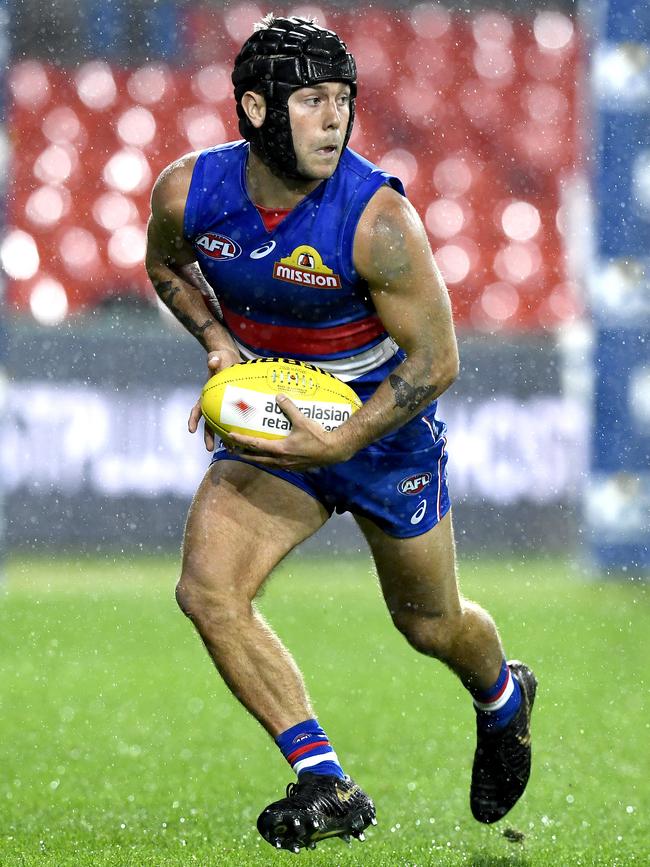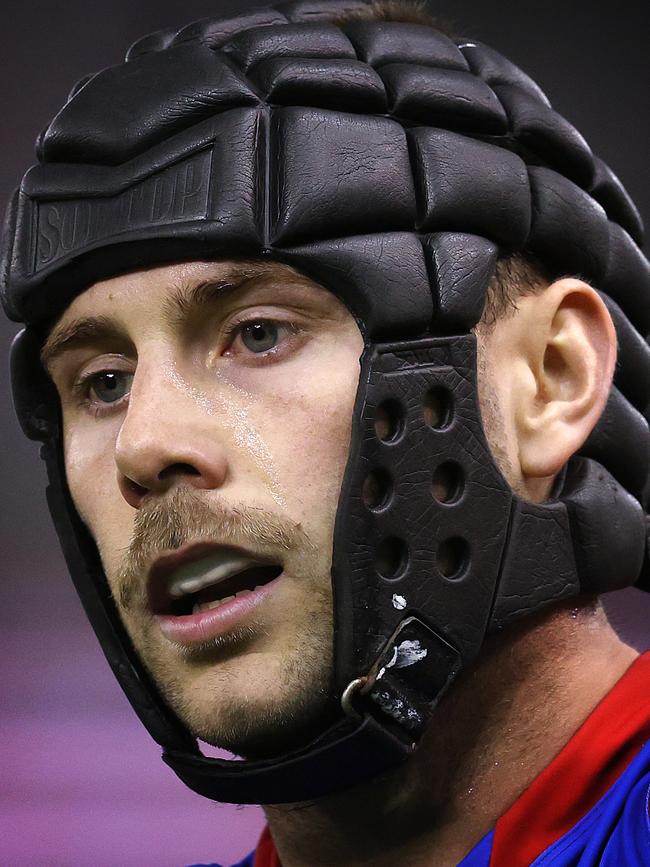AFL concussion: Majority of Victorians say junior footballers should wear helmets
Junior footballers should be required to wear helmets, according to a new poll, however one AFL star warns it could give players “a false sense of bravado”.
News
Don't miss out on the headlines from News. Followed categories will be added to My News.
An overwhelming majority of Victorians believe all junior footballers should wear helmets on the field in a bid to combat head knocks and concussion.
Medical experts and past and present AFL stars have added their voices to calls to make it mandatory for children aged up to 12 to wear protective head gear while playing footy.
A statewide poll of 1484 Victorians – a larger sample than usual – has revealed 80 per cent of Victorians support junior leagues making helmets mandatory.
More than 58 per cent said they “strongly support’’ the move, given increasing evidence linking head knocks and concussions to long-term brain damage.

Females were most supportive of making helmets mandatory for juniors but men and women from all parts of the state supported the idea.
Western Bulldogs star Caleb Daniel — the AFL’s highest profile helmet wearer — hoped the findings led to more children donning head protection.
“Parents are trying to look out for their kids and I think it’s great if its implemented a little bit more,’’ he said.
“For me it’s about kids having the comfort, being able to put their head over the ball and going in for it.


“And if that means they are wearing a helmet and playing with confidence from doing that, I don’t think you can’t take that away from them.’’
Regional Victorians were biggest backers of the move, with 61 per cent pledging their “strong” support.
Females gave the concept an 85 per cent thumbs up, males 67 per cent approval and men and women aged over 60 were most in favour of making helmets compulsory for kids (85 per cent).
Just 8.9 per cent of Victorians “opposed” the idea and 3.4 per cent were “strongly opposed”.
A combined 83 per cent of western Melbourne residents and 80 per cent of those from regional Victoria and eastern Melbourne supported or strongly supported the idea.
A three year AFL and Monash University study into the effectiveness of headgear in prevention of concussion is due to be concluded within months.
The findings are likely to influence whether helmets should be mandatory at any age group.
But AFL spokesman Jay Allen said “limited research to date’’ had failed to produce evidence “currently available headgear prevents concussion”.

“The AFL does not recommend against the use of headgear,’’ he said.
“It does caution against misunderstandings that might arise from the use of headgear including by players wearing headgear and their opponents, and advise all players still need to be careful while contesting the ball.’’
Associate Prof Richelle Mychasiuk, of Monash University’s department of neuroscience, said there were benefits of helmets.
“They are useful when it comes to protecting for catastrophic head injuries, skull fracture, orbital facial bone damage – that is what helmets are actually really protective for,’’ she said.
She said helmets could give youths “a false sense of security” but the poll results were interesting.
“I don’t think it’s that surprising given seatbelts are there to protect you and the assumption is that helmets will be protective,’’ she said.
Murdoch Children’s Research Institute has been monitoring whether kids concussed on the sporting field were wearing helmets, as part of its HeadCheck concussion app.
Clinical sciences director Prof Vicki Anderson said it was “not in concrete’’ that helmets offered no protection from concussion.
“We need to do more research – we don’t know for sure one way or the other and hopefully the HeadCheck will be able to tell us which kids have the worst injuries,’’ she said.
“If it is kids that don’t have helmets, then that is going to change our minds.’’

Concussion expert Prof Alan Pearce suggested helmets, if mandated, should come with a disclaimer.
“I don’t have a problem with a level of support for helmets being worn, we’ve just got to make sure people aren’t under the incorrect impression this will protect their brains from concussion,’’ he said.
Former high flying Melbourne and North Melbourne footballer Shaun Smith, last year
paid $1.4 million in concussion compensation, said people meant well by calling for compulsory helmet wear.
“The helmet stops you getting a cut or something like that, it might take a fraction off the bump,’’ he said.
But the Mark of the Century winner said helmets could give players a false sense of bravado and the only real protection was concussed players spending longer on the sidelines.
“At least in boxing, you get knocked out – that’s the end of the game, whereas we get knocked out, keep playing and play the next week,’’ he said.
“It’s just nuts.’’
Bulldogs midfielder Daniel said the more kids wearing helmets the better.
“I think it would be beneficial to push kids along to get out of their comfort zone and get out of the stereotype that wearing a helmet is soft,’’ he said.
Recent research has found concussions among junior footballers have increased threefold in recent years.
Some clubs already make it compulsory for kids to wear helmets but there is no statewide edict for leagues or teams to do so.
Yarra Junior Football League this year started scanning the brains of thousands of players, with boys and girls from under 8s offered a 10-second “EyeGuide” test after an on-field incident.
Mouthguards that monitor head knocks via computer chips, now used by AFL players, are expected to be available for juniors by 2023.
The poll was commissioned by the Herald Sun and conducted by bipartisan research and polling firm Redbridge between June 12 and 15.
MIXED RESPONSES ON WHETHER TO MAKE HELMETS COMPULSORY
Highett Football Club president Jason McGrath said the more younger junior footballers wear helmets “the better”.
“We have kids putting themselves in dangerous circumstances and you can’t coach that out of a player,” Mr McGrath said.

He said currently at his club each child, together with their parents, makes the call on whether they will take to the field with a helmet.
“There’s been mixed responses which is why at the moment we’ve chosen to make it a choice,” he said.
“My nephews play in the country leagues where (wearing helmets) is compulsory.
“They will continue to wear them as they have grown up with it. They know no different, so it’s easier to wear them.”
He estimates less than five per cent of players at Highett Football Club wear helmets and said his sons do not.
“I have raised it with them and have spoken about the pros and cons,” he said.
“The only con is the false sense of security … the benefits are obvious.”
“The biggest pro is not getting concussions.”
Darren Lewis’ daughter Healey, 9, plays for Highett Football Club and sports a pink helmet, a present from her grandmother.
“She asked for a helmet,” Mr Lewis said.
“She said she’d feel more comfortable. She doesn’t want to get a knock on the head.”
The Cheltenham father said young kids watch AFL matches and see how often players are taken off due to concussion.
“They pick it up,” he said.
“I’m not a massive fan of helmets but I’m not against them. I’m neutral.”
WHAT IS CTE?
Chronic Traumatic Encephalopathy (CTE) is a progressive degenerative disease of the brain found in people who have a history of repetitive brain trauma.
Brain trauma includes symptomatic concussions as well as asymptomatic sub-concussive hits.
The fluctuations in the brain can begin months, years, or even decades after the last brain trauma or active athletic involvement.
It is not known at this time the number or type of hits to the head needed to trigger degenerative changes.
WHAT IS A CONCUSSION?
A concussion occurs any time you have had a blow to the head that causes you to have symptoms for any amount of time.
You do NOT need to have lost consciousness to have a concussion.
Symptoms include blurred or double vision, ‘seeing stars’, sensitivity to light or noise, headache, dizziness or balance problems, nausea, vomiting, trouble sleeping, fatigue, confusion, difficulty remembering, difficulty concentrating, or loss of consciousness.
WHAT ARE THE SYMPTOMS OF CTE?
Symptoms can include memory loss, confusion, impaired judgment, impulse control problems, aggression, depression, suicidality, parkinsonism, and eventually progressive dementia.
HOW IS CTE DIAGNOSED?
The unfortunate reality of diagnosing CTE is that it can only be done after death by post-mortem neuropathological analysis.
– With Laura Placella and Millicent Spencer
More Coverage
Originally published as AFL concussion: Majority of Victorians say junior footballers should wear helmets





